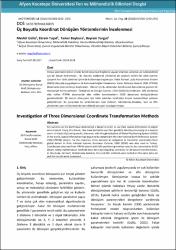Üç Boyutlu Koordinat Dönüşüm Yöntemlerinin İncelenmesi
Abstract
Dünya üzerindeki bütün ülkeler kendi konumsal bilgilerini sayısal ortamda saklamak ve kullanabilmek
için bir datum belirlemiştir. Bu datumu kullanarak ülkelerine ait jeodezik verileri bir altlık üzerine
işleyerek her türlü planlama işlerinde kullanmaya başlamıştır. Fakat Küresel Uydu Konumlama Sistemi
(GNSS) dünyada yaygınlaşması ile Konumsal bilgiler Uluslararası Yersel Referans Sistemi 1996 (ITRF96)
datumunda elde edilmeye başlamıştır. Ülkeler için bu datumdan kendi ulusal datumlarına geçmek bir
mecburiyet haline gelmiştir. Türkiye’de de Avrupa Datumu 1950 (ED50) kullanılmıştır. GPS alıcılarıyla
elde edilen ITRF96 datumunda elde edilen koordinatların ED50 datumuna dönüştürülmesi
gerekmektedir. 3D datum dönüşümü için bilim adamları tarafından birçok matematiksel yöntem
geliştirilmiştir. Bu çalışmada bu yöntemlerden olan Helmert, Moledensky-Bedakas, Veis ve Afin
yöntemleri aynı veri kümesinde test edilerek sonuçları karşılaştırılmıştır. All countries on the Earth have determined a datum in order to use their spatial information in digital
environment. Using this datum, they have started to use their geodetic data by processing on a base to
use in all kinds of planning works. However, with the globalization of Global Positioning System (GNSS)
in the world, spatial information has begun to be obtained in the International Earth Reference System
1996 (ITRF96) datum. For the countries, it has become an obligation to transform coordinates from
global datum to their national datums. European Datumu 1950 (ED50) was also used in Turkey.
Coordinates obtained from ITRF96 datum with GPS positioning method need to be converted to ED50
datum. Many mathematical methods have been developed by scientists for 3D datum transformation.
In this study, Helmert, Moledensky-Bedakas, Veis and Afin methods were tested on the same data set
and the results were compared.
Volume
18Issue
1URI
http://fenbildergi.aku.edu.tr/wp-content/uploads/2018/04/015503250-255.pdfhttp://hdl.handle.net/11630/4878



















